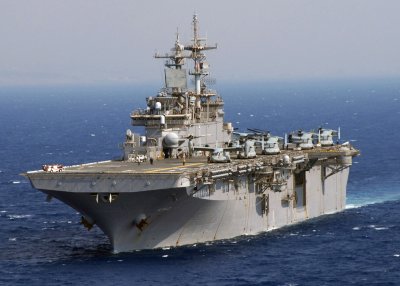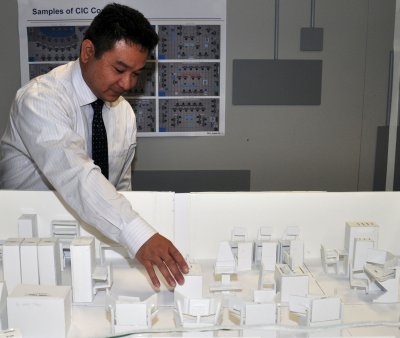
U.S. Marine Corps MV-22 Ospreys preparing for flight on the deck of the multipurpose amphibious assault ship USS Wasp (LHD 1). The ship's Combat Information Center (CIC) space is currently being analyzed by human systems integration engineers at Naval Surface Warfare Center Dahlgren Division. They plan to reconfigure the CIC to maximize operational effectiveness and optimize the work performance at individual watch stations.
What do you imagine when you hear the words - "designing spaces"?
Fans of a popular television reality program featuring home redecoration might think of transformed home interior spaces.
Navy human systems integration (HSI) engineers at the Naval Surface Warfare Center Dahlgren Division (NSWCDD) Human Performance Lab imagine transformed warship spaces that enable Sailors to achieve optimal performance.
However, the design process does not begin aboard a ship.
It begins at the Human Performance Lab where the Navy ship spaces are designed, redesigned, and transformed.
The WASP Class Amphibious Landing Helicopter Dock (LHD) mock-up Combat Information Center (CIC) is a case in point.
"We have a full-scale space analysis effort going on," said Alex Salunga, NSWCDD Surface Combat Systems Group Lead.
The LHD carries 1,200 crew and 1,800 Marines in various detachments.
"After our carriers, the amphibious assault ships are the biggest combatant ships in the Navy," said Jon Dachos, NSWCDD Command Center Design Lead.
Some of its other diverse functions include embassy rescues, humanitarian efforts and amphibious assaults.
"It has the largest hospital afloat in the Navy after the two Mercy Class Hospital ships," said Dachos. "It has a full intensive care unit with 64 patient beds and six operating rooms. An additional 536 beds can be set up in an 'Overflow Casualty Ward' as needed. It's a great ship - very capable. It carries about 40 aircraft."

Alex Salunga - Surface Combat Systems Group Lead at Naval Surface Warfare Center Dahlgren Division - uses a small scale model to explain why certain personnel work from specific areas aboard a WASP Class amphibious assault ship (LHD). The Combat Information Center (CIC) space is being analyzed by human systems integration engineers at Naval Surface Warfare Center Dahlgren Division. The engineers plan to reconfigure the ship's CIC to maximize operational effectiveness and optimize the work performance at individual watch stations.
The HSI tasking for the LHD mock-up required arranging the Combat Information Center space as optimally as possible to maximize operational effectiveness, said Salunga, adding that it could be done a couple of different ways, including taking a look at how to optimize the work performance for some of the individual watch stations.
"That's sort of the approach we took," Salunga said. "The process started out with identifying the watch stations we could focus on and identifying some experienced fleet personnel who could provide feedback."
Salunga cited surveys, interviews and a tool known as a "doll house" which is a portable layout display, explaining why certain personnel belong in specific areas. Information analyzed in the doll house includes dimensions of the space, amount of consoles within the space, and other important equipment.
"You can start placing things and coming up with various layouts," Salunga said. However, he also cautioned that with nine layout options, everything can't be depicted on such a small platform.
"You can't just bring fleet folks into a full-scale mock-up like this," Salunga said. "It becomes too difficult. With this (the doll house) platform, you can't necessarily achieve a variation in floor height from one set of consoles to another. Sometimes, even if it's a good idea, it gets eliminated because it's not executable."
Another tool the HSI branch uses is the Spatial Analysis Link Tool (SALT).
"SALT takes into consideration the relationships your subject matter experts identified as critical," Salunga said. "You take those relationships and input the fleet feedback, then the tool is able to rank layouts against each other."
A consensus from the fleet may rank one proposed layout over another or eliminate one altogether.
"Once we narrow it down to two or three layouts, then we'll do a full-scale mock-up," said Salunga, adding that HSI engineers can develop a scenario, bring the fleet in and show them different options.
At that point, Sailors engage in a scenario placing them in an environment physically representative of what the CIC looks like. The scenario sets up situations prompting Sailors to think about what else they may need, and if the layout being considered would support those needs.
"After that, they typically tweak the final layouts, and from that we rescore the layouts," Salunga said. "Sometimes there's a clear winner. Sometimes it's really close. Throughout the process we keep our stakeholders involved."
Once the layouts are analyzed, the HSI branch generates a report laying out the process. In all, 262 Sailors and stakeholders participated in the LHD mock-up.
"We protect their identities as part of our process," he said. "We record data as far as demographics such as rank and experience to give credence to the process. Once we do that, we formally submit the report along with our recommendation for the layout. Then the sponsor goes to the requirements office - in this case OPNAV (Office of the Chief of Naval Operations) and they'll officially sign off on the actual layout."
The lab can be divided and reconfigured in many different ways.
"Right now we have two full-scale mock-ups - a DDG Flight III and an LHD 2 in our lab," said Salunga. "We have a robust science and technology research and development team that looks into different ways they can aid the operator. This could link mental models to process or display information in the most efficient way for operators to make their decisions. Eliminating human error can be as simple as putting signs up in a particular area to assist the operator in doing or not doing something."
In addition to the implementation of simple signs, a doll house and SALT, the HSI branch also uses eye-tracking technology and lighting measurement, among other techniques.
"We have diverse tools available to support our analysis," Salunga said. "This lab is an analysis tool. We look at how we can use all of our different assets to provide our warfighters with the best answers. We like to be integrated into the process as early as possible."
Once the HSI branch is involved - not one stone is left unturned.
"We'll look at colors, text sizes, lighting and touch capability," said Dachos. "We'll perform task analysis on what the Fleet Sailor needs to do."
Navy engineers also look at whether information is displayed in the ideal manner for warfighters to accomplish their missions.
"That's what this amazing lab can do - the whole spectrum of providing for the user's needs to ensure Fleet operators can effectively use the hardware and software," Dachos said. "We're kind of the glue that integrates the end users with the systems."


